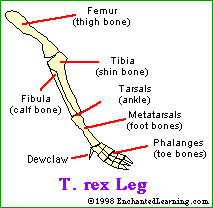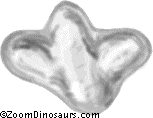 Dinosaurs usually walked on their toes; the scientific term for this is digitigrade. Other animals that are digitigrade include dogs, cat, and chickens. There is a pad of tissue on the back of the feet on these animals that acts like a shock absorber. People, bears, and crocodiles walk differently; they are plantigrade (flat-footed). Dinosaurs were slightly pigeon-toed; their toes pointed inwards.
Dinosaurs usually walked on their toes; the scientific term for this is digitigrade. Other animals that are digitigrade include dogs, cat, and chickens. There is a pad of tissue on the back of the feet on these animals that acts like a shock absorber. People, bears, and crocodiles walk differently; they are plantigrade (flat-footed). Dinosaurs were slightly pigeon-toed; their toes pointed inwards.
Some dinosaurs moved around on four legs (these are called quadrupeds), and some on two legs (these are called bipeds). Others may have run on two legs but walked and grazed on all four legs. Some dinosaurs were slow moving and others were speedy, depending on their anatomy. A few of the late, bird-like dinosaurs may have used their short, feathered arms to help speed up their running and perhaps glide from trees to the ground. Dinosaurs probably used their tails for balance while moving and some may have used their tails for quickly shifting their balance in quick turns.
 Many dinosaurs had dewclaws (also called a hallux), a small, functionless claw that didn't hit the ground.
Many dinosaurs had dewclaws (also called a hallux), a small, functionless claw that didn't hit the ground.
WHAT DO FOOTPRINTS TELL YOU?
Footprints can tell you a lot about the animal that made them. Footprints can give you information on:
- The animal's foot structure (like how many toes it had, which toes supported most of the weight, if there were pads on the feet, and if the animal was was flat-footed or not)
- How the animal walked (on two legs or four)
- How fast it moved (you can determine this using the distance between the prints and the leg length).
DINOSAUR SPEEDS
 Huge dinosaurs with short legs, like Apatosaurus, Diplodocus, Brachiosaurus, and the other sauropods, were probably among the slowest of the dinosaurs.
Huge dinosaurs with short legs, like Apatosaurus, Diplodocus, Brachiosaurus, and the other sauropods, were probably among the slowest of the dinosaurs.
 Massive, heavily plated, low-slung dinosaurs, like the Ankylosaurids, must have been among the slower of the dinosaurs, but recent trackways found in Bolivia, South America indicate that they weren't as slow as previously thought.
Massive, heavily plated, low-slung dinosaurs, like the Ankylosaurids, must have been among the slower of the dinosaurs, but recent trackways found in Bolivia, South America indicate that they weren't as slow as previously thought.
 The speediest dinosaurs were the bird-like, bipedal carnivores (theropods) with long, slim hind-limbs, and light bodies. These fast dinosaurs probably weren't any faster than modern-day land animals. For example, Ornithomimus was a fast, agile dinosaur, probably running about as quickly as an ostrich
The speediest dinosaurs were the bird-like, bipedal carnivores (theropods) with long, slim hind-limbs, and light bodies. These fast dinosaurs probably weren't any faster than modern-day land animals. For example, Ornithomimus was a fast, agile dinosaur, probably running about as quickly as an ostrich  , which can run up to 43 mph (70 kph).
, which can run up to 43 mph (70 kph).

A Hadrosaur footprint. |
Paleontologists can deduce approximate dinosaur speeds by using fossilized trackway and the dinosaur's skeletal structure. In 1976, the British zoologist R. McNeill Alexander used elephants, birds, people, and many other living animals to formulate an equation relating an animal's speed, leg length, and its stride length. Solving for speed, the equation is:
Speed (m/sec)=0.25*(stride length)1.67*(leg length)-1.17*(gravitational constant)0.5
The gravitational constant is 9.8 m/sec2. Leg length is estimated using Alexander's equations relating hip height to the length of the part of the foot that hits the ground. This is necessary because it is very difficult to determine which dinosaur made a set of tracks. (ref: Alexander, R.M., 1976, Estimates of speeds of dinosaurs, Nature 261: 129-130)
- Fossilized Trackway -
 When good series of footprints are found, they show whether a dinosaur was walking, trotting, running, or wading. The distance between prints is measured together with the size of the tracks. From this, rough speeds can be calculated. Ichnotaxa (fossil footprints)
When good series of footprints are found, they show whether a dinosaur was walking, trotting, running, or wading. The distance between prints is measured together with the size of the tracks. From this, rough speeds can be calculated. Ichnotaxa (fossil footprints)  have yielded information about dinosaurs' locomotion, speed and length of stride, whether they walked on two or four legs,
have yielded information about dinosaurs' locomotion, speed and length of stride, whether they walked on two or four legs,  , foot structure, and how the tail is carried (no tail tracks have been found, so tails were probably held erect). Unfortunately, linking a set of tracks with a particular species of dinosaur is virtually impossible.
, foot structure, and how the tail is carried (no tail tracks have been found, so tails were probably held erect). Unfortunately, linking a set of tracks with a particular species of dinosaur is virtually impossible. 
- Skeletal Structure (morphology) - After dinosaur skeletons are reconstructed from fossil remains, their leg length and estimated mass can be used to calculate their approximate maximum speeds This can be done by studying living animals whose bodies move in similar ways.
Using Alexander's equations, the follow speeds were calculated by R. A. Thulborn (1982, University of Queensland, Australia):
- Sauropodamorphs to 5 km/h (about the walking speed of people)
- Stegosaurs and ankylosaurs to 6-8 km/h
- Most sauropods walked about 12-17 km/h, with maximum of 20-30 km/h
- Large theropods (like T. rex) and ornithopods to 20 km/h
- Ceratopsians to 25 km/h
- Small theropods, ornithopods to 40km/h
- Ornithomimids to 60 km/h
- People are estimated to run up to 23 km/h (fast sprinting speed)
RUNNING AND THE MASSIVE, SHORT-ARMED THEROPODS
 There has been some discussion on whether or not the massive, short-armed theropods (like T. rex, Giganotosaurus, and Allosaurus) could run very fast because if they fell, their short arms would not break their fall and they would be badly injured (James Farlow, 1995). This meant that these large theropods were slow, lumbering animals.
There has been some discussion on whether or not the massive, short-armed theropods (like T. rex, Giganotosaurus, and Allosaurus) could run very fast because if they fell, their short arms would not break their fall and they would be badly injured (James Farlow, 1995). This meant that these large theropods were slow, lumbering animals.
Dr. Bruce Rothschild, of the Arthritis Center of Northeast Ohio, has found evidence of 14 fractured ribs in an Allosaurus that reflect healed injuries that were probably received in falls. These were most likely bellyflops that happened while running while running (as reported in the April 16, 1998 New Scientist).
 An x-ray analysis of the Allosaurus fossil indicated that the Allosaurus ribs near the scapula (the shoulder bone) were cracked and had healed. The Allosaurus was capable of recovering after many severe forward tumbles that probably occurred while it was running. So the suggestion that perhaps the large short-armed theropods were not capable of running because they couldn't recover after a fall apparently wasn't so, at least for Allosaurus - this Allosaurus did recover many times after bad tumbles.
An x-ray analysis of the Allosaurus fossil indicated that the Allosaurus ribs near the scapula (the shoulder bone) were cracked and had healed. The Allosaurus was capable of recovering after many severe forward tumbles that probably occurred while it was running. So the suggestion that perhaps the large short-armed theropods were not capable of running because they couldn't recover after a fall apparently wasn't so, at least for Allosaurus - this Allosaurus did recover many times after bad tumbles.
In 1995 James Farlow of Indiana-Purdue University argued that a large T. rex could run no faster than 20 mph (32 kph), because if it did, a fall would probably be so severe as to kill it. T. rex weighed about 6 tons and was up to 20 feet (6 m) tall but Allosaurus was slightly smaller, about 3 tons and 16.5 feet (5 m) long. Farlow says that Rothschild's analysis is consistent with his theory since Allosaurus was smaller than T. rex (its smaller mass would make the impact much less powerful so the animal may have been able to recover after a running fall).


 Huge dinosaurs with short legs, like Apatosaurus, Diplodocus, Brachiosaurus, and the other sauropods, were probably among the slowest of the dinosaurs.
Huge dinosaurs with short legs, like Apatosaurus, Diplodocus, Brachiosaurus, and the other sauropods, were probably among the slowest of the dinosaurs.
Massive, heavily plated, low-slung dinosaurs, like the Ankylosaurids, must have been among the slower of the dinosaurs, but recent trackways found in Bolivia, South America indicate that they weren't as slow as previously thought.
The speediest dinosaurs were the bird-like, bipedal carnivores (theropods) with long, slim hind-limbs, and light bodies. These fast dinosaurs probably weren't any faster than modern-day land animals. For example, Ornithomimus was a fast, agile dinosaur, probably running about as quickly as an ostrich
, which can run up to 43 mph (70 kph).